8 Yoga Moves to Strengthen Your Knees
March 22nd 2020
Source: Yoga Journal
Do you have knee pain? Many people suffer from chronic knee or joint pain from arthritis, osteoarthritis, or simply strain from everyday life. Fortunately, yoga exercises are a proven remedy, although they can seem daunting for beginners.
When you’re doing yoga, it’s important to do the poses with the correct form. Practicing with a cautious pace will help you get positive results.
Here are eight yoga poses that can strengthen your knees and help alleviate knee pain:
1. Triangle Pose
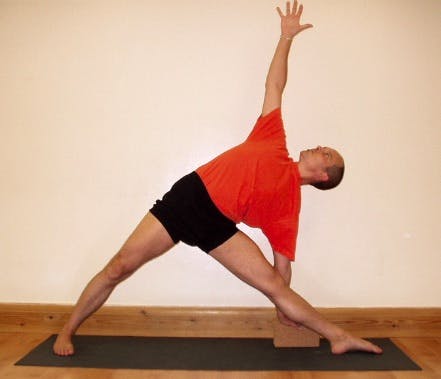
Source: Wikipedia
A weak vastus medialis (the inner part of the quadriceps) and vastus lateralis (the outer part of the quadriceps) can cause injury. To help prevent it, the triangle pose in yoga will stretch and strengthen your inner thigh muscles.
The triangle pose is done by stepping your feet out at a broad stance to ensure they are parallel with your back, with your right foot turned at a 90-degree angle, parallel with the horizontal edge of the mat.
Your right knee should be bent in line with your hip and ankle, and both feet should be rested as your right leg straightens to engage your inner quad and thighs.
It's vital to align the right knee with the hip and ankle in order to reach the right arm down to the left side of the body, forming a straight line. Keep the core engaged by placing a block to support the right hand as you try to reach out to the sky with the left side of the body. Slowly inhale and exhale. Then repeat the procedure.
Warning: Joining your muscles makes it difficult to lock your knees, but disengaging them will lead to hyperextension. Since hyperextension will lock your muscles, it should be avoided at all costs.
Interested in learning more healthy tips and tricks? Click here.
2. Mountain Pose
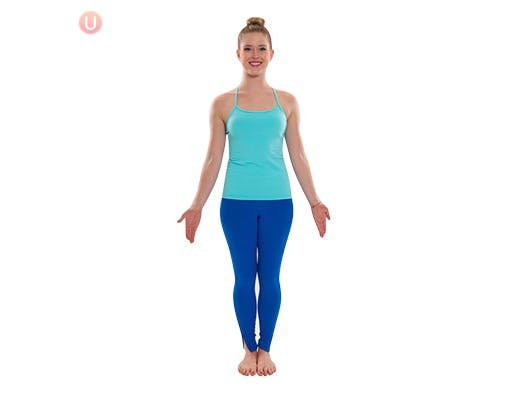
Source: Get Healthy U
This yoga position helps to properly align the muscles to relieve knee pain. The first step is to ensure that your feet are placed close together. Engaging your core and feet, lift up through your core. Press on the floor to evenly distribute your body weight to engage your calf muscles. Use your quadriceps and rotate your thighs to help you feel the stretch and tighten your abs.
Pull your shoulders back and down to ensure that they are stacked over your ankles and hips while lifting your chin slightly; your chin should be parallel to the floor. Relax your face muscles and take deep breaths to relax your engaged muscles, and hold onto this posture for approximately 10 breaths.
3. Supported Half Moon Pose
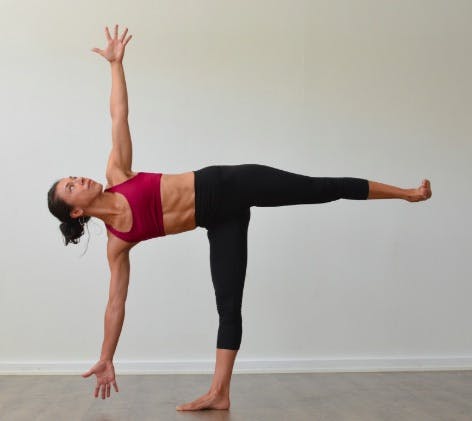
Source: Wikipedia
The Supported Half Moon Pose is also called the Ardha Chandrasana. This balancing pose is beneficial in building strength in the muscles that support the knee. The first step is to find an empty wall and a block for support. Then, stand with your back to the wall and rotate the right foot. Make sure the bottom of your foot is parallel to the wall. After that, place the block in your right hand, then bend your right knee. Shift your weight so that you are balancing on your right leg.
Set the block on the floor near the front of the right foot, and apply pressure to your right hand to straighten the right arm and leg. Rotate the left side of your body in an upward direction so that the back is in alignment with the wall behind you. The left leg should be parallel with the floor, and the left arm should create a straight line with the right arm. Hold this position for a couple of seconds; take a few deep breaths and increase the duration of the pose gradually as you get stronger.
4. Supported Bridge Pose
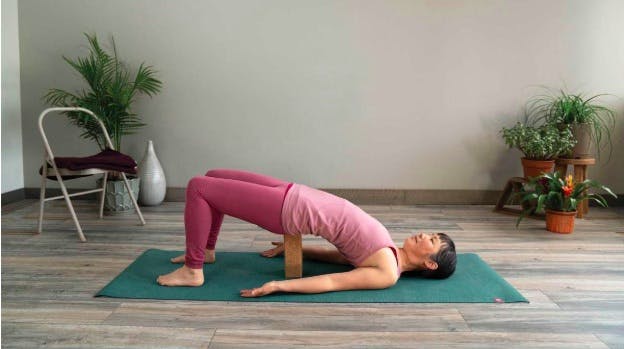
Source: Yoga Journal
Bridge pose, known as the Setu Bandasana, is a yoga move that aligns your knees to strengthen the glutes, back, and hamstrings. The first step is to lie flat on your back with your knees bent. Then, place your feet on the floor so that your knees are bent. Put your feet out at a hip distance apart and place a block horizontally on the floor. This will stabilize everything, so all you have to do is to push all four corners of the feet, the inside and outside edges, and the heels. After that, draw the navel toward the spine and push the lower back into the ground. Tuck the tailbone in and lift the bottom from the ground as high as you can without compromising your form.
To stretch the chest, you can roll the shoulders under your body and interlace your fingers underneath. Hold this pose for a few breaths or seconds, then release your upper back back down to the floor. After that, gradually release the mid-back, and finally, lower the lower back and tailbone to the floor. Repeat this move a few times to get optimal results.
Want to read about more exercises? Check out our blog.
5. Chair Pose
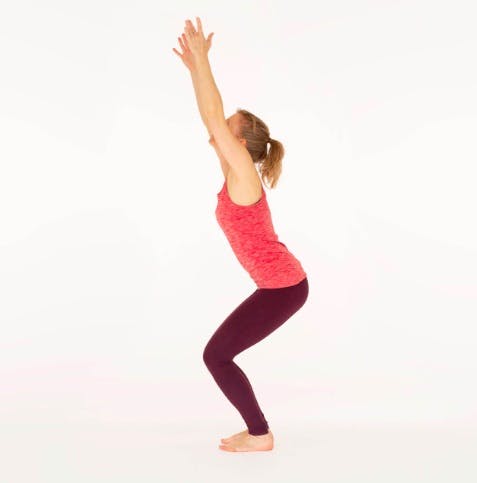
Source: Ekhart Yoga
The chair pose strengthens your thigh muscle (the rectus femoris). Strong thigh muscles will support your knees.
First, place your feet together. Reach your arms straight past your face. Then squat down slowly. Squeeze your thighs as you go down. Your body will reach a diagonal sitting position. Hold this yoga pose for a moment while taking controlled, deep breaths. Then, stand back up.
6. Child’s Pose
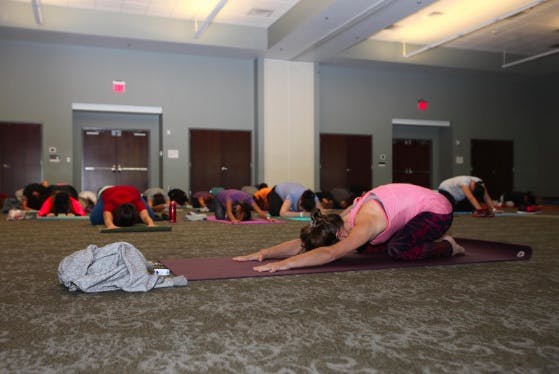
Source: Cherry Point Marines
This gentle knee stretch can be intensified the closer you move your bottom toward the heels. The first step is to grab a blanket and place it under the knees for protection. Then get on your hands and knees, and make sure you have your feet together with your toes untucked, and knees separated so the belly can rest between the thighs. Your bottom should be touching your heels, and your forehead should be on the mat with your arms extended outward. Hold the pose for 10 breaths and gradually increase it as you get more flexible.
7. Easy Pose
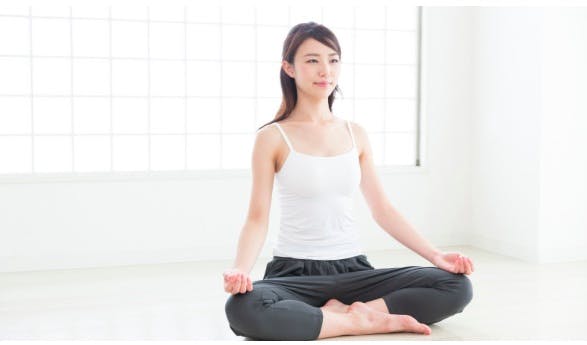
Source: Yoga U Online
This is a common pose in most yoga classes. Just sit down, cross your legs, and sit up straight as if you’re meditating. You might feel some tension depending on the extent of your knee bend, and the pose can be more comfortable by sitting on a blanket. It’s great for stretching your ankles and knees, and once the move is completed, it's best to stand and take up to 10 deep breaths.
8. Wide-Angle Seated Forward Bend

Source: Yoga Awakening
The Wide-Angle Seated Forward Bend, also known as the Upavistha Konasana, is an excellent pose that stretches out the back, hip, inner thigh, and groin. The first step is to straddle your legs out in the widest stance possible, while still maintaining comfort. Then flex your feet to stimulate the leg muscles, and place your hands on the ground forward in front. Keep the spine elongated and straight throughout the process. Hold this pose for ten breaths, then pull the legs together and the knees towards the chest.
Final Note
Don't let knee pain or stiffness slow you down because these yoga poses can strengthen and alleviate knee problems. To prevent injury, you should warm up before your yoga session to improve flexibility and range of motion. Don't forget to incorporate yoga into your strengthening routine, and keep track of your runs with SportMe so you can make progress with intention.
